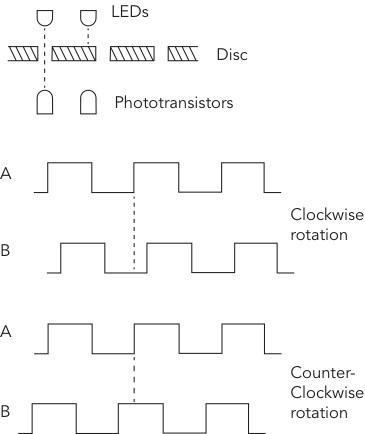Encoders Know All the Angles
January 4, 2013

Engineers use rotary encoders to measure the angular position of an attached device, such as a motor shaft, or to measure distance indirectly when used with a linear belt drive, for example.
Rotary encoders come in two types: digital and analog. Digital rotary encoders comprise two categories: incremental and absolute. An incremental encoder produces n digital pulses for each 360-degree rotation of the encoder's shaft. An absolute encoder provides an x-bit binary code that indicates a specific angular position.
Incremental encoders rely on an opaque disc with a concentric ring of small, equally spaced holes placed near the disc's outer edge. Light from LEDs on one side of the disc shines through the holes on to two phototransistors on the opposite side. As the disc rotates, the out-of-phase transistors create two pulse signals. The number of holes in the disc ranges from hundreds to several thousand. Equipment can count these pulses to determine incremental angular changes.

The two phototransistors generate square waves out of phase with each other, as shown in the figure. This phase relation shifts when the encoder changes direction. As an option, some incremental encoders produce a separate index pulse signal once per revolution to indicate a specific position or the start of another revolution. A controller circuit can count pulses from one output to determine the shaft's angular position. The pulse-phase relationship indicates direction of encoder shaft rotation. By measuring the time between pulses, or by counting the number of pulses over a specific time, software can calculate a shaft's rotational velocity and acceleration. When equipment power goes off, though, you lose track of an incremental encoder's position.
An absolute encoder provides a unique binary output as the encoder's shaft rotates. If you require an absolute location with, say, a 15-minute resolution or 1,440 unique codes, a 12-bit absolute encoder with 4,096 codes would work well. You would have 360/(212) unique codes for a resolution of 5.3 minutes. Loss of power does not affect the encoder, so you know the position of a mechanism attached to your encoder when power returns.
Like incremental encoders, many absolute encoders rely on an encoder disk and a series of phototransistors -- one per bit.
Absolute encoders also might use a rotating magnet and a stationary Hall effect sensor to produce binary angular position codes. Encoder manufacturers offer straight binary and Gray code binary outputs. Engineers use absolute encoders in robotic and other equipment that requires coordination of movements on many axes. By using the Gray code, which changes only one bit per increment, engineers can avoid any electrical glitches caused by multi-bit transitions such as 01111 to 10000.
Do you have a measurement question you'd like answered here? Contact me at [email protected].
For more information, consult the Encoder Application Handbook from Danaher Industrial Controls.
Related posts:
About the Author(s)
You May Also Like
.jpg?width=300&auto=webp&quality=80&disable=upscale)


